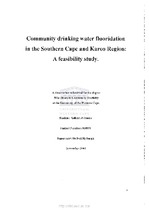| dc.contributor.advisor | Myburgh, Neil | |
| dc.contributor.author | Dennis, Gilbert J. | |
| dc.date.accessioned | 2015-10-20T14:19:22Z | |
| dc.date.available | 2015-10-20T14:19:22Z | |
| dc.date.issued | 2002 | |
| dc.identifier.uri | http://hdl.handle.net/11394/4600 | |
| dc.description | Magister Scientiae Dentium - MSc(Dent) | en_US |
| dc.description.abstract | The prevalence of dental decay is high among lower socio-economic groups in the Southern Cape and Karoo region. 70 - 80% of State employed dentists' time in this region is spent on attempting to reduce the pain and sepsis within the communities for which the primary treatment modality is extraction of the tooth under emergency conditions. In developing countries the prevalence of dental decay is still high. There is a general downward trend of dental decay in developing countries; and it is associated with combinations of exposure to fluoridated water and/ or other forms of fluoride exposure (e.g. in fluoridated tooth paste), the
provision of preventive oral health services, an increase in dental awareness through organized oral health education programs and the readily available dental resources. This study looked at the feasibility of implementing community water fluoridation in the Southern Cape and Karoo Region by describing the primary drinking water sources, the population distribution around these sources and the actual levels of fluoride found in the water samples. Each sample was coded and with the use of a global positioning system (GPS), a set of co-ordinates obtained for
each. Other options with regard to fluoride supplementation were explored as an attempt to provide an alternative intervention option for exposure to fluoride where community drinking water fluoridation was not the first option. This information will be used to record and update existing tables for fluoride levels in community drinking water of the communities in the Southern Cape and Karoo region that is
currently used as a guide for prescribing fluoride supplementation as a means of prophylaxis for the prevention and reduction of dental decay. This study re-iterated the diverse set of variables that communities living in rural areas have to
live with. It supports the trend that in developing countries the DMFT (12 years) and dmft (6 years) are higher than those in the same age cohorts of developed countries. This study shows that the fluoride level in borehole water is generally higher than that of dams or reservoirs. Fluoride supplementation is required in the bigger, densely populated areas as the fluoride levels of the water in these areas are below optimal and their water systems can accommodate fluoridation. The long term gains of community water fluoridation at optimal levels for entire communities by far out way the risk of developing fluorosis at above optimal levels. There needs to be a systematic review of treatment needs and treatment modalities for each
community so that at some point the need for prevention strategies will be sought out by program managers as best practice for improving the general health (i.e. and oral health) of their communities. There is no single approach for solving issues in communities with different sets of variables determining their needs and so too to the question of community water fluoridation. The recommendation is that at the community level (i.e. the communities should be empowered to do their own situational analysis and prioritize their needs) people need to make decisions for
themselves with regard to the type of preventive strategy that they implement. Once they have the data and an intervention option is arrived at, they should lobby with their local health provider to implement that intervention option (e.g. Exposure to fluoride as a means of improving dental health) that they have identified in their towns or villages. | en_US |
| dc.language.iso | en | en_US |
| dc.publisher | University of the Western Cape | en_US |
| dc.subject | Southern Cape | en_US |
| dc.subject | Karoo | en_US |
| dc.subject | Dental decay | en_US |
| dc.subject | Developing countries | en_US |
| dc.subject | Flouride exposure | en_US |
| dc.subject | Fluorosis | en_US |
| dc.subject | Water | en_US |
| dc.subject | Fluoridation | en_US |
| dc.title | Community drinking water fluoridation in the Southern Cape and Karoo Region: a feasibility study | en_US |
| dc.type | Thesis | en_US |
| dc.rights.holder | University of the Western Cape | en_US |

